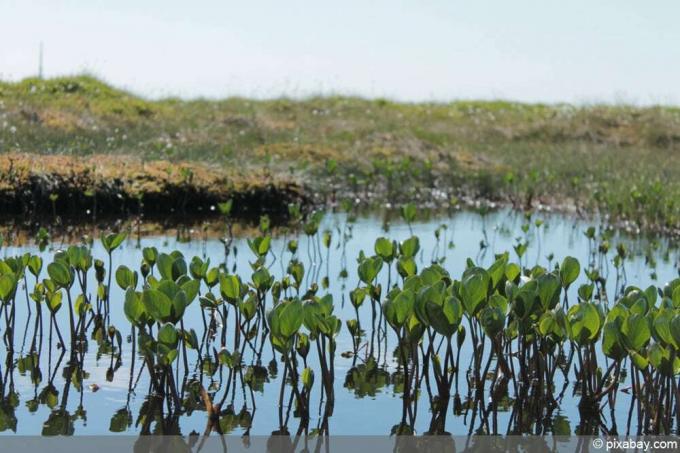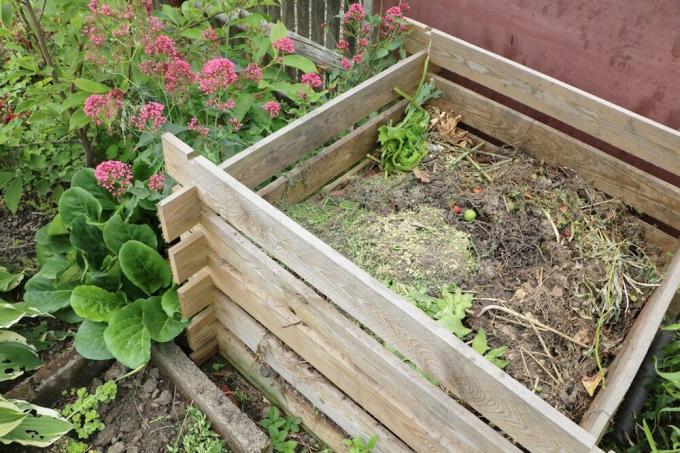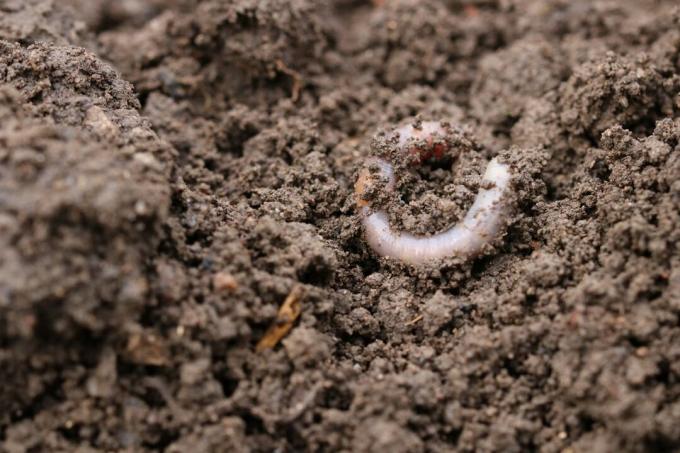

Table of contents
- What is peat?
- What does peat do as a culture substrate? - Advantages and disadvantages
- Not using peat protects the climate and nature
- Useful alternatives for the garden and vegetable patch
- compost
- bark humus
- wood fibers
- peat moss
Peat has lost its spotless reputation as the perfect garden soil. Today, the classic substrate is criticized for being environmentally harmful and destructive. In the ecologically managed garden and vegetable patch, home gardeners are questioning the use of peat with growing skepticism. This guide will familiarize you with all the important pros and cons so that you can make an informed decision about your private green kingdom.
What is peat?
Exact knowledge of the origin and composition paves the way for a mature judgment as to whether or not peat should be used as a substrate in the garden. Most hobby gardeners are not aware that they are holding a valuable piece of moor in their hands with a sack of garden peat or potting soil. Peat is the stuff our scenic moorlands are made of.
Bogs are constantly wet habitats where low, undemanding plants thrive. Constant excess water ensures a low-oxygen soil and blocks the complete decomposition of dead plants. While plant residues turn into humus in soil with alternating humidity, they are deposited as peat in the moor. Layer by layer, the peat in raised bogs grows above the groundwater level at a leisurely rate of 1 mm to a maximum of 10 mm per year. The well-known Teufelsmoor near Worpswede, for example, took 8,000 years to develop into its current splendor. In contrast, fens form in river valleys and depressions or are the result of silting up on lake surfaces. Peat grows less strongly here and is overgrown with more species than in raised bogs.

The world's largest moor areas stretch across the taiga belt along the northern hemisphere. Russia, Alaska and Canada also have huge bogs. In Germany there are well-known moor landscapes in the north and in the foothills of the Alps. Not only does precipitation fall in abundance in these regions. In addition, there is high humidity there, which is a key factor in the formation of the unique high and low moors.
What does peat do as a culture substrate? - Advantages and disadvantages
Traditionally, peat is still used today as a fuel in a wide variety of areas, because compacted, dried peat soil has a similar calorific value as lignite. The spectrum ranges from power generation and whiskey distillation to heating greenhouses. Since the beginning of the 20th At the end of the 19th century, commercial and private gardeners became interested in peat as a growing medium. The following properties catapulted peat to the top of the most popular potting soils:
- Stores many times its own weight in water
- Lowers the pH in the soil
- Loosens compacted soil and optimizes permeability
The positive characteristics make peat indispensable for commercial nurseries and nurseries Cultivation of rhododendrons, azaleas, hydrangeas and other plants on acidic soil are dependent. However, when promoting garden peat for private ornamental and kitchen gardens, the trade ignored important negative effects of the substrate:
- Once dried out, the water storage capacity is lost
- Poor rewettability results in increasing soil compaction
- Acidification of the soil with simultaneous release of heavy metals
- Minimal nutrient content requires additional application of artificial fertilizer
Garden peat is only recommended if you limit yourself to growing plants in the garden and vegetable patch that prefer acidic soil with a pH of 4 to 5. The vast majority of woody, perennial and vegetable plants thrive in neutral to slightly alkaline soil with a balanced pH of 6 to 7. If peat comes into play here, diseases and stunted growth are inevitable.
Tip:
No prior knowledge of chemistry is required to determine the pH of your garden soil. You can purchase test sets in garden centers and hardware stores that you can use to determine the acidity of the soil yourself.
Not using peat protects the climate and nature
The garden and vegetable patch only benefit from peat in exceptional cases. The negative effects do not only predominate in the context of the cultivation of ornamental and useful plants. Excessive peat extraction has irretrievably destroyed huge moorland landscapes around the world and on our doorstep. In this context, valuable habitat was lost for rare animals and plants.
An often underestimated consequence of the rigorous extraction of peat is the release of carbon dioxide. The numbers are alarming. In Germany alone, destroyed peat soils release more than 40 million tons of greenhouse gases every year. This value is on par with the CO2 emissions of all German aviation. The conscious avoidance of peat and peat-containing potting soil in the home garden makes a valuable contribution to the preservation of unique moor landscapes and the reduction of emissions.
Useful alternatives for the garden and vegetable patch
The renunciation of the use of garden peat is not associated with any restrictions in plant care in the home garden. On the contrary, there is a colorful array of environmentally friendly alternatives that do not require a crumb of peat. Incidentally, gardening without peat is not a modern invention, but a return to a traditional and well-established practice. Proven options for your garden and vegetable patch are discussed in more detail below:
compost

In an ecologically managed garden, the compost heap is part of the basic equipment. Vegetable waste from the garden and kitchen is converted into a valuable natural fertilizer with substrate quality as part of a rotting process lasting several months at temperatures of up to 70 degrees. Hard-working soil organisms make an important contribution to the formation of humus. Additions of fall leaves, wood cuttings and rock flour promote the decomposition process. The result is a hygienically perfect peat substitute with good rewettability, a high nutrient content and a proven protective effect against pathogens. Heavy feeders in the vegetable patch, like all types of cabbage, thrive when cultivated with pure compost. Less demanding ornamental plants prefer a mixture of one-third each of compost, bark humus and wood fibers. Mineral additives such as sand, expanded clay or grit are recommended for use as a bucket substrate. There is no place for peat in this balanced interaction of environmentally friendly components.
bark humus
Crushed softwood bark is composted into bark humus and results in a popular peat substitute. As one of the most densely forested countries in Europe, tree bark is also available in Germany as an almost inexhaustible source for a continuous supply as an alternative to peat. Growth-inhibiting substances in fresh coniferous bark, such as resin, tannin or tannins, are almost completely broken down over the course of several years of fermentation. Bark compost has a reliable structural stability and has a stable pH value. Furthermore, the rewettability is better than with garden peat. In commercially available, peat-free soil, the proportion of bark humus is up to 50 percent. The rising price is a disadvantage. As a renewable raw material, tree bark is becoming increasingly important for energy production, which is driving up prices. For this reason, southern countries have already started to prefer pine bark as a substitute for peat-free substrates.
wood fibers
Chemically untreated wood provides the starting material for a high-quality peat substitute. Sawmill residues, such as shavings or wood chips, are processed using a thermo-mechanical process, which optimizes their properties and makes them a perfect substrate. Wood fibers score with a high air capacity, first-class drainage effect and good rewettability. The low nutrient and salt content, low bulk density and reliable freedom from weeds are also advantageous. If you mix in garden soil or compost with up to 50 percent wood fibers, waterlogging doesn't stand a chance. Substrate with wood fibers dries more quickly on the surface, so that moss and flying weed seeds have no basis for germination and growth.
Tip:
If you have banned peat from the garden and vegetable patch, the focus is on growing media for indoor plants. Coconut fibers or cocopeat consist of the fibers of ropes, carpets or mats. As an additive in compost and garden soil, the fiber material can completely replace peat.
peat moss
Research and development in the cultivation of peat moss as a peat substitute is still in its infancy. However, the first results in 2016 are promising. Peat mosses of the genus Sphagnum are cultivated on peated, rewetted raised bog areas in order to to gain a biomass as a raw material for the production of growing media for the garden, balcony and windowsill. Pilot projects have shown that ornamental and useful plants thrive in soil with an 80 percent peat moss content.

Great efforts are being made not only in Germany, but also in Europe and worldwide to produce a full-fledged and socially recognized peat substitute with peat moss. Time is pressing, because the peat extraction areas are declining sharply. As a result of the social ostracism, the countries find it difficult to issue new permits, which would result in more moors being destroyed. In the state of Lower Saxony alone, the forecasts assume that the mining areas will increase by almost Halve 12,000 hectares in 2012 to 6,000 hectares in 2022 and to under 1,000 hectares by 2037 to reduce.
 garden editorial
garden editorial I write about everything that interests me in my garden.
Learn more about floor care

Digging up the garden: 13 tips for lawns and beds
Whether it makes sense to dig up beds or lawns is discussed in different ways. Once you have decided on this measure, our tips will help you to organize work in the garden effectively.

Pine bark: suitable for which plants?
Pine bark is a type of mulch that is gaining popularity among many garden owners due to its color and properties. Before purchasing, the question often arises as to which plants the bark mulch is suitable for. This question is justified because of the origin of the pine.

Which soil to choose for elephant foot?
The right substrate is crucial for the elephant's foot and should therefore be chosen well. Read here which soil is best suited for the Beaucarnea recurvata!

Expanded clay as a water reservoir: The alternative to earth?
Expanded clay is known to many as a substrate for hydroponics or as drainage in pots. Due to its properties, the clay granulate is suitable as a substrate in many different areas and can replace soil. The granules have long been an indispensable basis for green roofs.

Potting soil: Mix the potting soil yourself
Potting soil has to meet special requirements. It can therefore often make sense to mix potting soil yourself. This comes with several advantages. But what do you have to pay attention to? The guide below shows how to do it.

pH value in the soil: 15 tips for measuring & regulating
If the pH of the garden/plant soil is suboptimal, this can lead to serious plant damage. We show what options there are for measuring and regulating.
